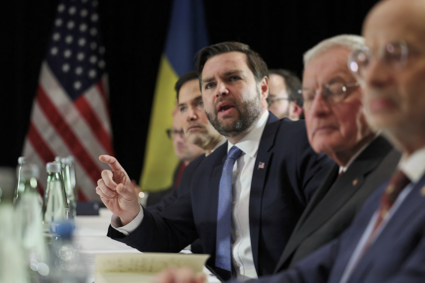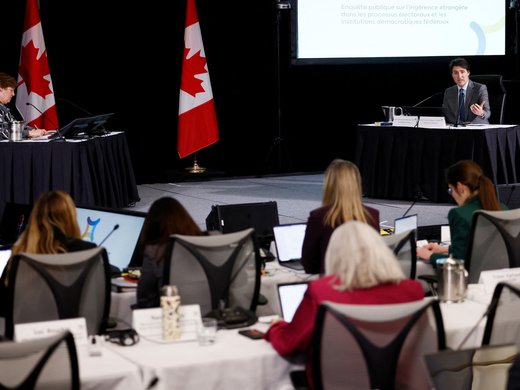For the second consecutive year, the World Economic Forum’s Global Risks Report has identified disinformation as the most significant short-term global risk that could destabilize democratic institutions, polarize societies and erode trust in truth. And yet, US Vice President J. D. Vance, speaking at the Munich Security Conference in February,dismissed the concept of disinformation as “old entrenched interests hiding behind ugly Soviet-era words,” which, in his view, were being used to impose censorship.
At the same time, as Meta curtails its fact-checking programs, X becomes a haven for far-right apologetics and Elon Musk fans, and Canadians maintain a high level of content dependence on the United States, we need to reflect: What does this constellation of concerning trends mean for Canada, particularly in the face of increasing foreign interference, proliferating unchecked digital content and shifting dynamics in domestic political discourse, all while our neighbourhood becomes less safe?
The final report from Justice Marie-Josée Hogue’s commission conducting the Public Inquiry into Foreign Interference (PIFI), which sought to highlight that Canada is no longer facing a complete “hands-off” approach when it comes to foreign disinformation campaigns, appears to suggest that the government’s overall attitude is that “there is no cause for widespread alarm.” While the commission found that foreign interference did not play a decisive role in the outcomes of previous elections, this finding about one particular element of a much wider problem should not invite complacency.
In response to this preliminary outcome of an inquiry of relatively narrow scope, the government must now shift from focusing only on election integrity and the policy-making community to seeking a deeper understanding of how everyday Canadians interact with information — particularly on social media platforms — and how foreign narratives infiltrate their media consumption, shape public perception and influence voting preferences over time. Discourse should include not only the foreign dimension but also the fact that our adversaries masterfully leverage domestic actors to meddle in Canada’s democracy through media, academia and the public sector.
One of the greatest vulnerabilities to disinformation in Canada stems from its fragmented media ecosystem. The country’s diverse population, spread across linguistic and cultural enclaves, often receives news through niche channels, making it particularly susceptible to targeted disinformation. Foreign actors, including Russia and other authoritarians, have capitalized on this by infiltrating platforms that are widely used within specific diaspora communities. For instance, Telegram, known for its privacy concerns and links to Russian government entities, has emerged as a key vector for Kremlin-backed propaganda that undermines trust in Canadian institutions and spreads anti-Ukrainian narratives.
During the 2022 Freedom Convoy protests, Russian state-backed outlets such as Russia Today (RT) significantly amplified coverage compared to mainstream Canadian news organizations, leveraging the event to inflame division and distrust in government. Information from these platforms is widely consumed by Canadians with Russian heritage, despite Canadian sanctions having been placed against these Russian outlets. Consequently, these platform-based media sources continue to have a significant impact on the formation of public opinion among certain groups of Canadians.
European countries, particularly those with a history of Russian disinformation attacks, have adopted more proactive approaches — not only to counter this threat but also to communicate their own narratives.
Another concerning factor is the influence of the US media ecosystem on Canadian discourse. This influence is particularly problematic given that US-based influencers, some of whom are directly funded by foreign entities, actively spread narratives damaging to Canadian democracy. A compelling example is the recent US Department of Justice indictment against two RT employees for financing Tenet Media, a company owned by Canadians Lauren Chen and Liam Donovan. Chen and Donovan received around $10 million for propagating Russian narratives across social media through their network of influencers.
Research by the Canadian Digital Media Research Network has documented the scope and activities of this operation: a survey found that approximately one-quarter of Canadians are aware of Tenet Media influencers, and an analysis of Tenet-affiliated podcasts revealed that nearly 500 out of 1,952 episodes contained discussions about Canada, often in a highly polarized and negative light. These discussions frequently targeted immigration policies and social justice movements, reinforcing societal divisions. Such tactics align with Russia’s broader disinformation strategy of exploiting domestic tensions in target countries.
European countries, particularly those with a history of Russian disinformation attacks, have adopted more proactive approaches — not only to counter this threat but also to communicate their own narratives actively. They have moved away from the reactive approach of attempting to debunk every falsehood, as this requires extensive resources from the targeted country. Russian foreign disinformation campaigns often deploy the “Firehose of Falsehood” strategy, flooding the information zone with contradictory and disinformation narratives to overwhelm fact-checkers and policy makers.
Utilizing frameworks such as DISARM (disinformation analysis and risk management) or ABCDE (actor-behaviour-content-degree-effect) to analyze and mitigate the impact of foreign information manipulations and interference (FIMI) could be useful in addressing this issue. More tools and strategies can be implemented, but the key lies in launching proactive strategic communications to shape the information environment rather than simply reacting to disinformation. Such proactive measures should be added to Canada’s efforts to detect, deter and counter foreign interference.
A critical component of proactively countering foreign narratives is the development of strong, credible Canadian media voices. Investing in local media platforms, independent investigative journalism, stars and digital influencers who can produce engaging content with a uniquely Canadian perspective is essential. Canada must foster a media ecosystem that speaks to its diverse population and provides compelling alternatives to foreign narratives.
Ukraine saw a surge in Ukrainian-language media, content and digital influencers following the Revolution of Dignity in 2014 and the Russian invasion in 2022, escaping the “common cultural space” trap and finding one of the methods to successfully counter Russian narratives that had long dominated the information space. Canada should develop a cohesive national media strategy prioritizing homegrown content creators and digital platforms to secure the cognitive sovereignty of Canadians. South Korea’s investment in its cultural and media industry bolstered national identity and increased global influence, serving as an impressive tool for soft power.
To effectively combat disinformation, Canada must develop an advanced monitoring and response system that continuously assesses the digital information landscape and measures the effect of such interventions. This system should map out and monitor potential disinformation platforms, track and analyze evolving narratives and test the effectiveness of different counter-messaging strategies.
Such an approach would allow for targeted interventions rather than blanket fact-checking, which often fails to reach audiences already embedded in disinformation ecosystems. Governments should adopt commercial-style marketing techniques in their strategic communications efforts to make them more efficient. OpenMinds, an artificial intelligence start-up specializing in information environment analysis, offers one example of how data-driven approaches and the implementation of strategic communication, coupled with measuring the effectiveness of these efforts, can counter disinformation effectively. There are many more solutions to address it, such as Osavul and Mantis Analytics.
Ultimately, no policy and technical interventions can fully shield a population from disinformation unless individuals are equipped with the tools to critically assess the information they consume. In an era when the very concept of foreign interference can be weaponized against political adversaries, we need to educate and encourage people to consider context and apply a healthy level of skepticism when assessing content. Otherwise, fear of foreign interference can be as damaging to democracy as FIMI itself.
Finally, Canada’s response must ensure that the work of the PIFI commission does not become merely a symbolic exercise. Rather than languish within the pages of a final report, PIFI’s findings must serve as a springboard for concrete policy actions, to foster a more resilient information ecosystem, one that can recognize and withstand the destabilizing forces of disinformation.
Reprinted with permission from The Hill Times, which previously published a version of this article.



